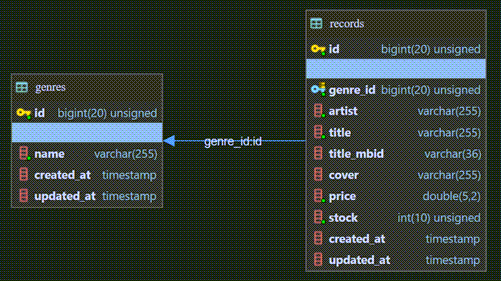# PHP backend
- The following examples are based on the database from the course PHP-Laravel.
- Only the tables
genresandrecordswill be used.

# Database connection
- The file
connection.phponly contains the variables to connect to the database. - All other pages in this chapter use the same connection.
- By keeping the connection in a separate file, you only have to maintain the code in one place.
<?php
// Database connection
$DB_HOST = 'localhost';
$DB_USERNAME = 'root';
$DB_PASSWORD = 'password';
$DB_DATABASE = 'databaseName';
// Set response headers
header('Access-Control-Allow-Origin: *'); // Enable CORS
header('Content-Type: application/json');
http_response_code(200); // response code 200: OK
// Open connection to database
try {
$conn = new PDO("mysql:host=$DB_HOST;dbname=$DB_DATABASE;charset=utf8", $DB_USERNAME, $DB_PASSWORD);
$conn ->setAttribute(PDO::ATTR_ERRMODE, PDO::ERRMODE_EXCEPTION);
$conn ->setAttribute(PDO::ATTR_DEFAULT_FETCH_MODE, PDO::FETCH_ASSOC);
} catch(PDOException $error) {
http_response_code(400);
echo json_encode([
"error" => 400,
"message" => $error->getMessage()
]);
die();
}
1
2
3
4
5
6
7
8
9
10
11
12
13
14
15
16
17
18
19
20
21
22
23
24
25
26
2
3
4
5
6
7
8
9
10
11
12
13
14
15
16
17
18
19
20
21
22
23
24
25
26
- Lines 4 - 8:
Before you can access data in the MySQL database, you have to connect to the server.
On https://panel.sinners.be/database you will find all the data for your own hosting. - Line 10: the page is also accessible outside your own domain (CORS)
- Line 11: the MIME media type for JSON text is
application/json - Line 12: the
HTTP 200 OK status codeindicates that the request was successful. - Line 22: A
400 Bad Request Errorindicates that the request could not be processed by the server.
A 400 error ends up in thefail()methode of jQuery's$.getJSON(). - Line 17: specifies how PDO displays error messages.
- Line 18: specifies that PDO displays the result as an associative array.
# Examples
# Get all records
- Get all records from the table
recordsand display the result as an array of JSON objects.
[{...},{...},{...}] - Live preview: https://pverhaert.sinners.be/cordova/master_1.php
<?php
include_once('connection.php');
// get all `records`
$query = "SELECT * FROM records";
try {
$records = $conn->prepare($query);
$records->execute();
$result = $records->fetchAll();
} catch(PDOException $error) {
http_response_code(400);
$result = [
"error" => 400,
"message" => $error->getMessage()
];
}
echo json_encode($result);
1
2
3
4
5
6
7
8
9
10
11
12
13
14
15
16
17
18
19
20
2
3
4
5
6
7
8
9
10
11
12
13
14
15
16
17
18
19
20
- Line 3: import (paste) the code from
connection.phphere. - Line 6: place the query you are going to execute here.
- Line 20: transform the array into a JSON object.
(You can also include additional parameters such asJSON_PRETTY_PRINTorJSON_THROW_ON_ERROR.)
# Get all records (ordered by artist)
- Live preview: https://pverhaert.sinners.be/cordova/master_2.php
<?php
include_once('connection.php');
// get all `records` ordered by `artist`
$query = "SELECT id, artist, title, price
FROM records
ORDER BY artist";
try {
$records = $conn->prepare($query);
$records->execute();
$result = $records->fetchAll();
} catch(PDOException $error) {
http_response_code(400);
echo json_encode([
"error" => 400,
"message" => $error->getMessage()
]);
}
echo json_encode($result, JSON_PRETTY_PRINT);
1
2
3
4
5
6
7
8
9
10
11
12
13
14
15
16
17
18
19
20
21
22
2
3
4
5
6
7
8
9
10
11
12
13
14
15
16
17
18
19
20
21
22
# Get all records with genre (ordered by artist)
- Live preview: https://pverhaert.sinners.be/cordova/master_3.php
<?php
include_once('connection.php');
// get alle `records` with `genre`, ordered by `artist`
$query = "SELECT records.id, artist, title, genres.name AS genre
FROM records
JOIN genres ON records.genre_id = genres.id
ORDER BY artist";
try {
$records = $conn->prepare($query);
$records->execute();
$result = $records->fetchAll();
} catch(PDOException $error) {
http_response_code(400);
echo json_encode([
"error" => 400,
"message" => $error->getMessage()
]);
}
echo json_encode($result);
1
2
3
4
5
6
7
8
9
10
11
12
13
14
15
16
17
18
19
20
21
22
23
24
2
3
4
5
6
7
8
9
10
11
12
13
14
15
16
17
18
19
20
21
22
23
24
# Get all genres with the associated records
- Live preview: https://pverhaert.sinners.be/cordova/master_4.php
<?php
include_once('connection.php');
// get all `genres` with the associated `records`
$query = "SELECT genres.name, records.id AS record_id, artist, title
FROM genres
JOIN records ON records.genre_id = genres.id";
try {
$genres = $conn->prepare($query);
$genres->execute();
$result = $genres->fetchAll(PDO::FETCH_GROUP); // group by `genre`
} catch(PDOException $error) {
http_response_code(400);
echo json_encode([
"error" => 400,
"message" => $error->getMessage()
]);
}
echo json_encode($result);
1
2
3
4
5
6
7
8
9
10
11
12
13
14
15
16
17
18
19
20
21
22
2
3
4
5
6
7
8
9
10
11
12
13
14
15
16
17
18
19
20
21
22
# Select one record with id as parameter
- Live preview:
<?php
include_once('connection.php');
// selecteer één `record`
$record_id = $_GET['id'] ?? 999999;
$query = "SELECT * FROM records WHERE records.id = $record_id";
try {
$record = $conn->prepare($query);
$record->execute();
$result = $record->fetch(); // use fetch() instead of fetchAll() => object instead of array with 1 object
} catch(PDOException $error) {
http_response_code(400);
echo json_encode([
"error" => 400,
"message" => $error->getMessage()
]);
}
echo json_encode($result);
1
2
3
4
5
6
7
8
9
10
11
12
13
14
15
16
17
18
19
20
21
22
2
3
4
5
6
7
8
9
10
11
12
13
14
15
16
17
18
19
20
21
22
# Bonus
- Download all examples from this chapter.
- Open
index.htmlin a browser. - Open
ìndex.htmlin PhpStorm and study how to build the page with jQuery's$.getJSON().